Policymakers and stakeholders throughout Washington, D.C. have spilled plenty of ink on the Biden administration’s fiscal year (FY) 2023 budget request over the past few weeks, but one little-discussed proposal deserves more scrutiny from Congress – and an immediate rejection.
Eagle-eyed observers of the President’s budget request may have noticed that, on pages 141 and 145 of the Office of Management and Budget (OMB) document, OMB analysts estimated FY 2023 requests for defense spending, non-defense spending, and Veterans Affairs (VA) Medical Care Program spending. OMB also compared each of those requests to spending levels enacted by Congress in the current fiscal year (2022) and prior fiscal year (2021).
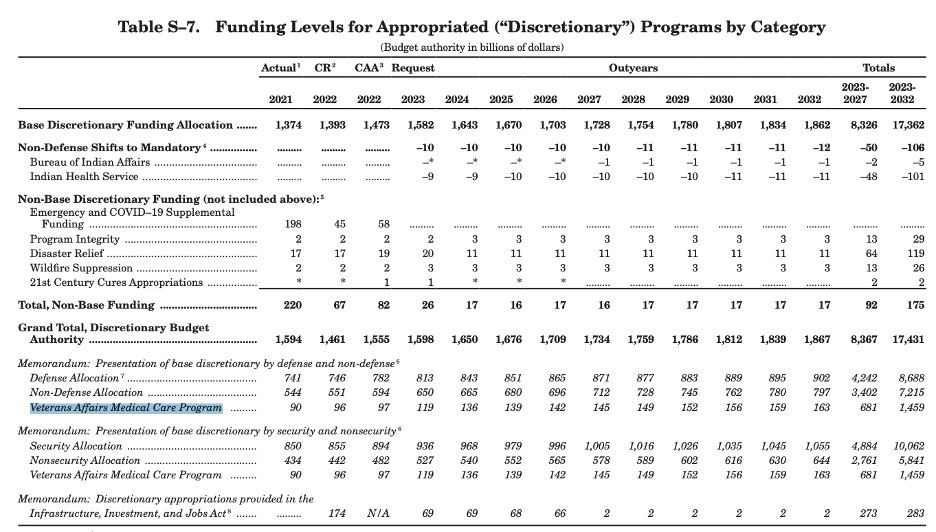
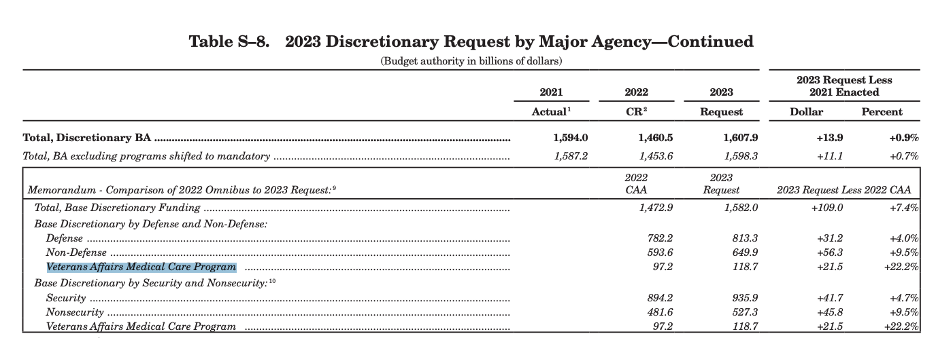
The latter category, VA Medical Care Program spending, is new. The distinction did not appear in President Biden’s first budget request, for FY 2022, and it did not appear in the Trump administration’s final budget request, for FY 2021.
It turns out the distinction is intentional, too.
Deep in its 332-page Analytical Perspectives document for FY 2023, the Biden OMB explains why spending for the VA Medical Care Program is listed separately in the budget request:
“For non-defense, the 2023 Budget proposes to separate out the Veterans Affairs (VA) medical care program, requested at $119 billion, from the rest of non-defense discretionary spending, requested at $650 billion.
…The Budget separates VA medical care as a third category within the discretionary budget based on a recognition that VA medical care has grown much more rapidly than other discretionary spending over time, largely due to systemwide growth in health care costs. Setting a separate budget allocation for VA medical care could help ensure adequate funding for veterans’ health care without shortchanging other critical programs.”
Department of Veteran Affairs Secretary Denis McDonough – also former President Obama’s chief of staff for four years – explained the Biden administration’s rationale further in an April hearing on the VA budget request for FY 2023[1]:
“‘For [VA medical care spending] to come at the expense of the rest of nondefense discretionary makes us less effective overall than we might otherwise be,’ McDonough told lawmakers at a House Appropriations Military Construction-VA Subcommittee hearing. His proposal quickly drew Republican pushback.
…The proposal would upend the way lawmakers usually negotiate annual spending bills. Congress typically sets high-level defense and nondefense spending levels early in the annual appropriations process, before determining more specific funding levels for each of the 12 bills.”
Republicans in Congress are correct to be concerned about this proposal, and Democrats in Congress should similarly be concerned. There are several reasons why the Biden administration’s proposal would make for terrible fiscal policy and could – if implemented – put upward pressure on federal spending for years or even decades to come.
Relief Valve for Spending
Congress has distinguished between “defense” and “non-defense” spending for decades, with VA medical care long falling in the latter category. Creating a third category exclusively for the VA Medical Care Program would make it appear to some as if Congress is reducing non-defense discretionary spending. This budget sleight of hand could make it easier for Congress to green-light future increases to non-defense discretionary spending – or, as the Biden OMB might euphemistically put it, avoid “shortchanging other critical programs.”
If Congress were to follow the Biden administration’s recommendation, it would appear as if there is a huge gulf between defense and non-defense discretionary spending for each of the next 10 years:
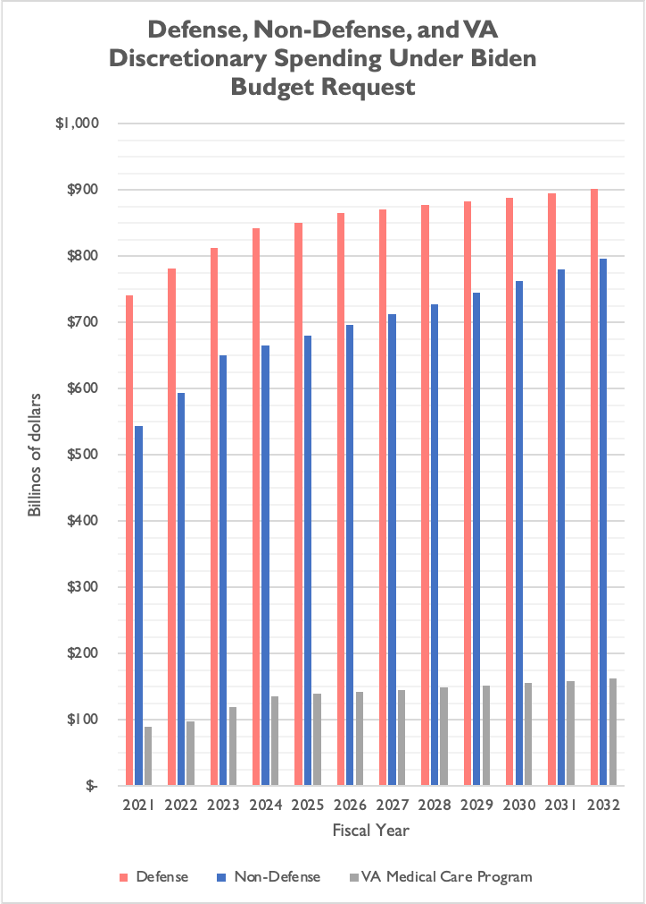
On the other hand, adding VA Medical Care Program spending back to non-defense discretionary spending, where it currently belongs, demonstrates that under the Biden FY 2023 budget request, non-defense discretionary spending would actually surpass defense discretionary spending in FY 2029.
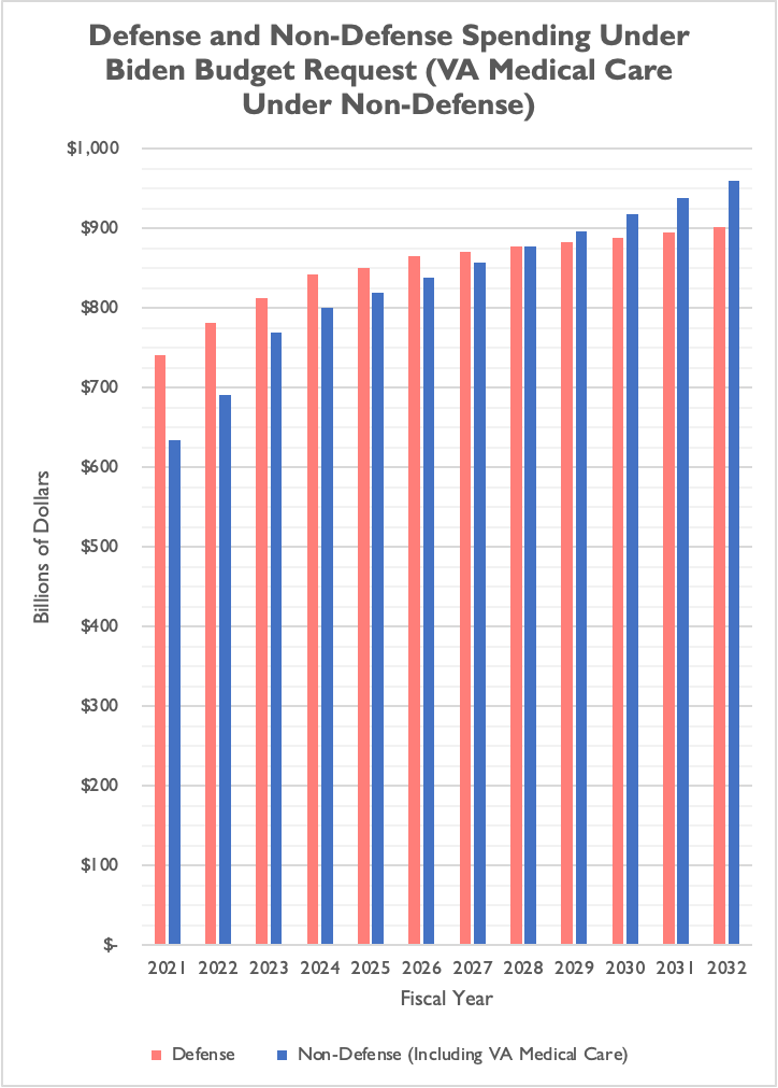
Now, NTU supports cutting both defense and non-defense discretionary spending. We don’t raise the above observations to suggest that defense discretionary spending should be higher than non-defense discretionary spending, or vice versa.
However, moving VA Medical Care Program spending to its own category would act as a relief valve for other non-defense discretionary spending requests, which Democrats like President Biden and his allies in Congress typically strongly support.
Redefining “Parity”
A related concern involves debates over “parity” between defense and non-defense discretionary spending. Of late, this concept has been advanced by Republicans – who serve in the minority in Congress – to win greater defense spending increases in Congressional appropriations than those recommended by the Biden administration and by Congressional Democrats.
However, this script could flip in the future, especially if Congressional Republicans (and Democrats) succeed at increasing the defense budget by large amounts from year to year. Now, parity can mean the same percentage increase in defense and non-defense spending from one year to the next, or it can mean the same dollar figure for defense and non-defense spending in a given fiscal year. If lawmakers measure parity in the latter way, then moving VA Medical Care Program spending to its own category will increase the amount of non-defense discretionary spending Democrats may demand to achieve “parity” with defense spending in the years ahead.
For example, under the current-law definition of defense and non-defense spending (with VA care in the latter category), defense spending is $44 billion higher than non-defense spending. Under the Biden administration’s newly proposed budget math (excluding VA care from non-defense), defense spending appears $163 billion higher than non-defense spending.
While parity is a bad budget concept no matter which party is using it, the Biden administration’s proposal could lead to much higher “parity” spending demands from Congressional Democrats and/or Democratic presidents in the near future.
Obfuscating the Cost of War
U.S. military operations have serious and significant consequences. Casualties are, without a doubt, the greatest consequence of war and conflict. Most policymakers and taxpayers would agree that the U.S. government – and, by extension, American taxpayers – have a responsibility to cover the health care needs of veterans who have injuries or medical conditions they sustained while serving their country.
VA medical care may not be classified as “defense” spending under federal budget rules, but rising taxpayer obligations for VA medical care do represent a significant portion of the cost of war. To the extent these costs eat into non-defense discretionary spending, these rising obligations should cause lawmakers to think carefully before investing in war, in large defense budgets, and in non-defense programs that the country cannot afford.
VA medical care spending has been on a skyrocketing trajectory in the 21st century, and Biden administration projections only underscore likely exponential growth.
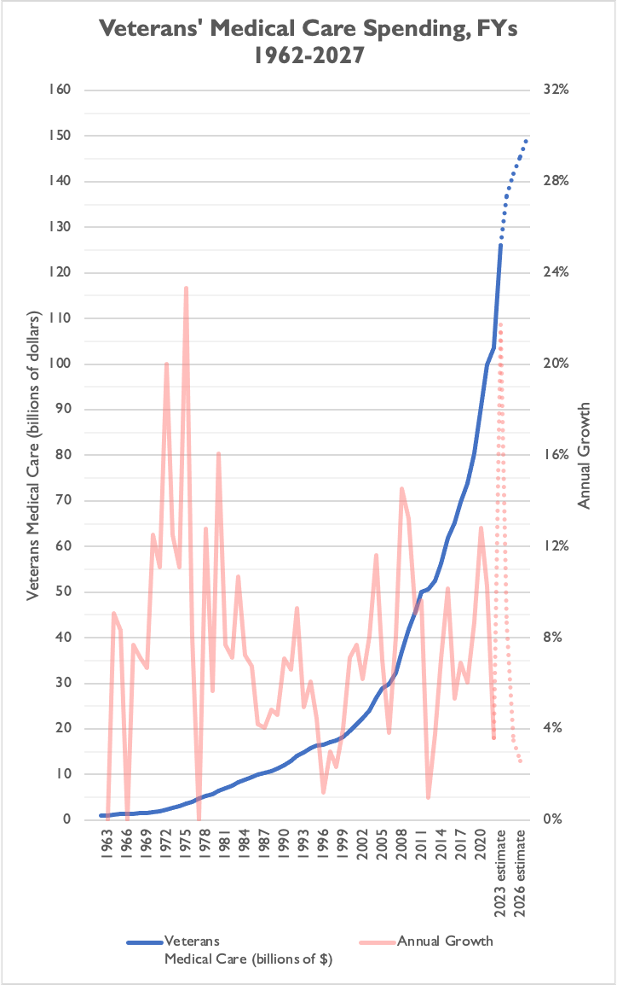
While the Biden administration’s proposal to change budget rules and conventions may be well-intentioned, the practical impact of the proposal would be to obfuscate the financial (and human) cost of war. The proposal would also put significant upward pressure on non-defense budgets for years or potentially decades to come. Like the anticipated fate of many other Biden administration budget and tax proposals, Congress should throw this one in the trash heap.
[1] The hyperlink leads to a story from Bloomberg Government’s Jack Fitzpatrick and is behind a paywall.

